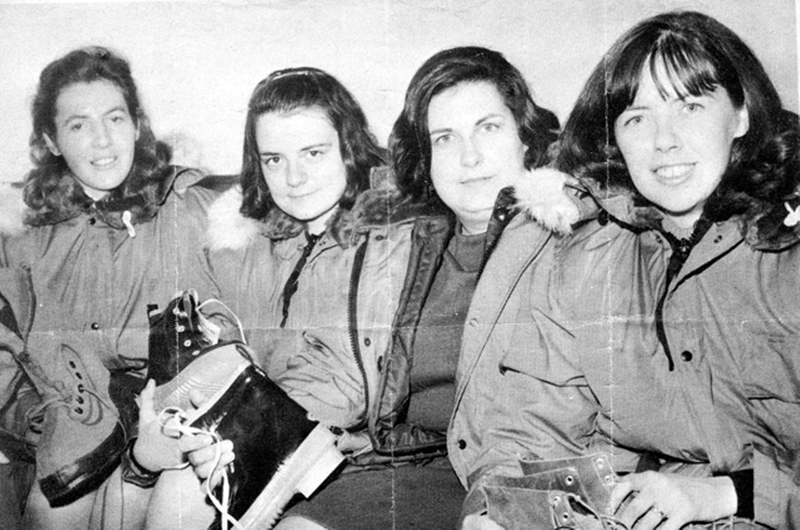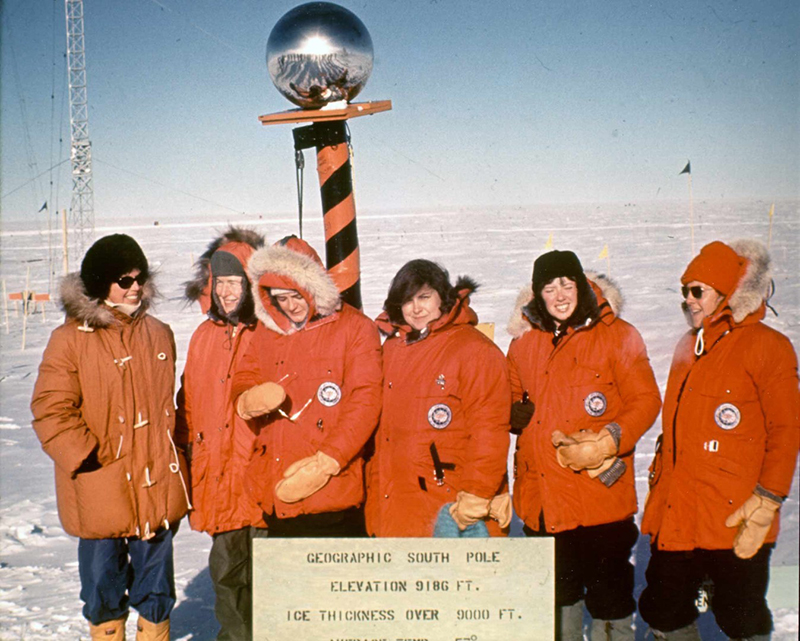When Women Reached the IceTwenty-Four Rarely Seen Images From the First All-Female Science Team in AntarcticaPosted October 14, 2019
In 1969, Lois M. Jones and her science team made history as the first all-female research team to work for the US Antarctic Program. They were studying the erosion of rocks in the McMurdo Dry Valleys, the subject of Jones's doctoral thesis the previous year. They made history as the first all-female science team on the continent and the first women to reach the South Pole, paving the way for countless women to follow in their footsteps. Now, 50 years later, rarely seen photos of that expedition, taken by team leader Jones and stored at the Byrd Polar Research and Climate Center archives, offer a unique glimpse into what life was like for these trailblazing women. This week the center is hosting a special Women in Antarctica symposium highlighting the contributions of women to polar research to commemorate this important milestone. 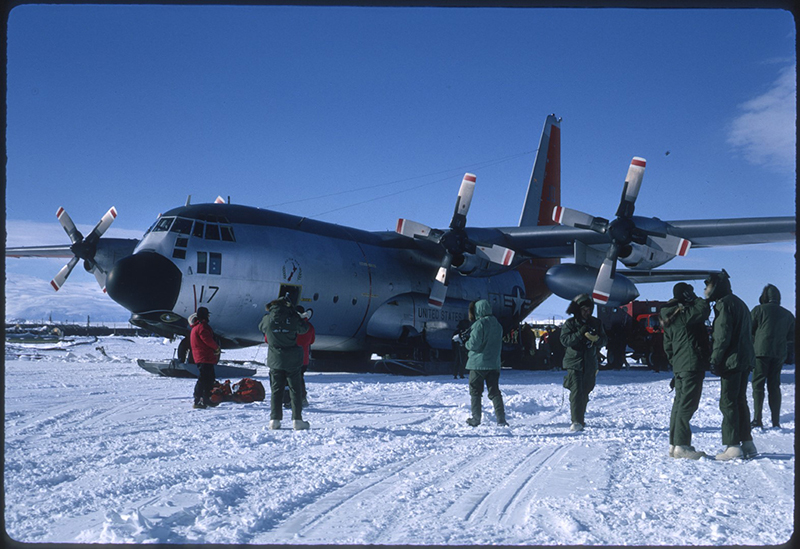
The team arrives at McMurdo Station in early November. After spending a few days in Christchurch, New Zealand being issued their cold-weather gear, they flew south in a ski-equipped C-130.
Photo Credit: Image 1592 Lois M. Jones Papers, SPEC.PA.56.0213, Byrd Polar and Climate Research Center Archival Program, Ohio State University

The view overlooking McMurdo Station Observation Hill. The research team spent several days in town, taking trainings and organizing their field camp equipment before flying to the McMurdo Dry Valleys.
Photo Credit: Image 365 Lois M. Jones Papers, SPEC.PA.56.0213, Byrd Polar and Climate Research Center Archival Program, Ohio State University

Navy sailors line up while researcher Terry Tickhill looks on. The all-male U.S. Navy provided logistical support to the US Antarctic Program during this era. The Navy had resisted sending women to Antarctica for years, and only allowed Jones's research team to go under the conditions that they had to spend nearly the entire season in the field at least 200 miles away from the station so they didn't "cause trouble" with the men. Members of the team were also told that if they weren’t successful, women wouldn't be allowed back to the continent.
Photo Credit: Image 1431 Lois M. Jones Papers, SPEC.PA.56.0213, Byrd Polar and Climate Research Center Archival Program, Ohio State University
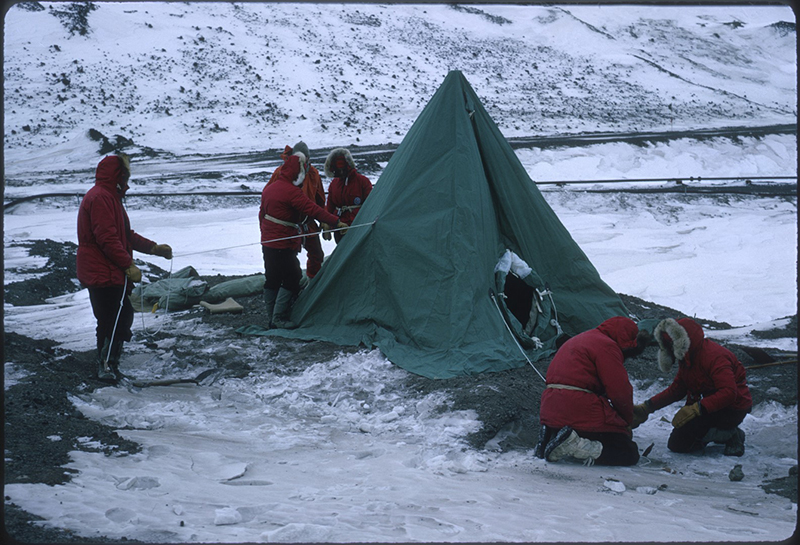
Before flying to the Dry Valleys, the team attended the New Zealand-led "snow school" to practice setting up tents, traversing crevassed landscapes and other safety skills.
Photo Credit: Image 1617 Lois M. Jones Papers, SPEC.PA.56.0213, Byrd Polar and Climate Research Center Archival Program, Ohio State University

Using helicopters piloted by the Navy's VXE-6 Helicopter squadron, the research team flew to the McMurdo Dry Valleys to collect rock, soil and water samples in the Taylor and Wright valleys as part of their geochemical research.
Photo Credit: Image 1470 Lois M. Jones Papers, SPEC.PA.56.0213, Byrd Polar and Climate Research Center Archival Program, Ohio State University
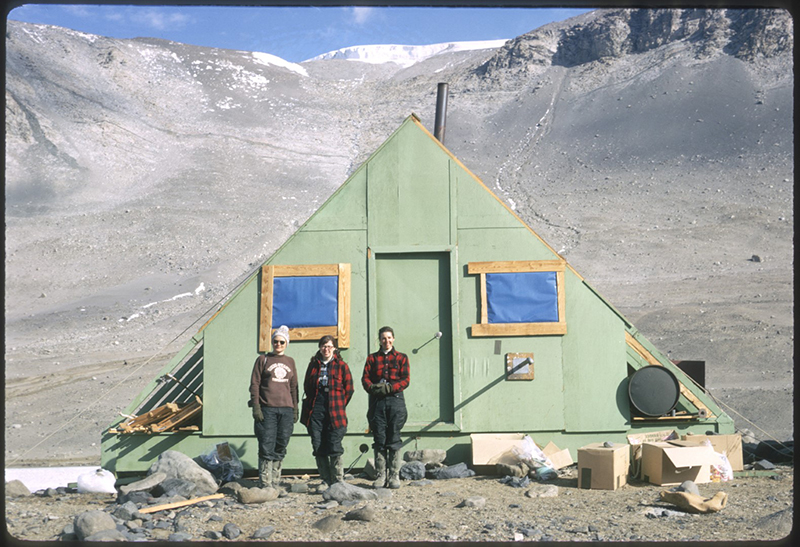
Their first campsite was the hut on the shores of frozen Lake Bonney in the Taylor Valley. (Left to right) Terry Tickhill, Eileen McSaveney and Kay Lindsay pose in front of the hut at Lake Bonney.
Photo Credit: Image 1002 Lois M. Jones Papers, SPEC.PA.56.0213, Byrd Polar and Climate Research Center Archival Program, Ohio State University

Two members of the team walk back from Sollas Glacier to the Lake Bonney hut through the moonscape of the Taylor Valley. Much of their time was spent collecting and carrying heavy backpacks full of rock samples.
Photo Credit: Image 730 Lois M. Jones Papers, SPEC.PA.56.0213, Byrd Polar and Climate Research Center Archival Program, Ohio State University

Terry Tickhill hacks away ice to melt for drinking water at Lake Bonney in the Taylor Valley. Then an undergraduate studying chemistry, Tickhill was hired in part be the camp manager, in charge of preparing meals and running the camp, in addition to her scientific expertise.
Photo Credit: Image 599 Lois M. Jones Papers, SPEC.PA.56.0213, Byrd Polar and Climate Research Center Archival Program, Ohio State University
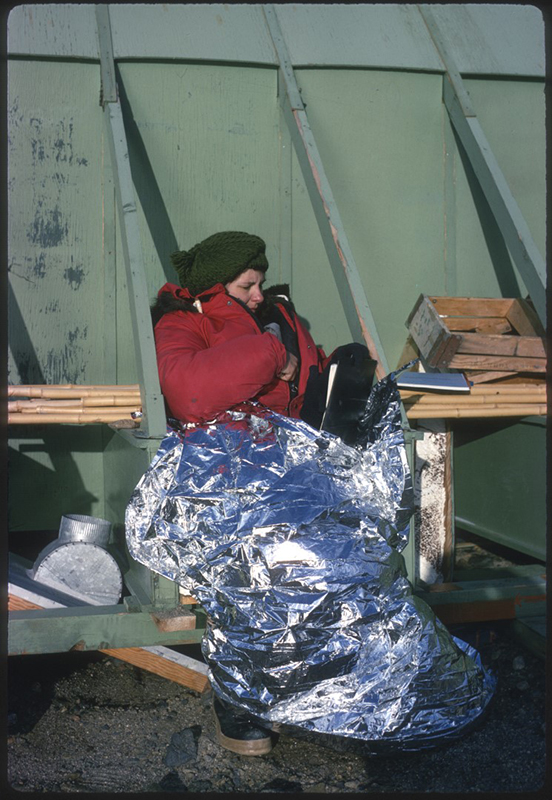
Jones sits outside, wrapped in a Mylar blanket for warmth at the Lake Bonney hut in the Taylor Valley. The hut's furnace didn't work when they first arrived, making for a cold start of their stay.
Photo Credit: Image 983 Lois M. Jones Papers, SPEC.PA.56.0213, Byrd Polar and Climate Research Center Archival Program, Ohio State University
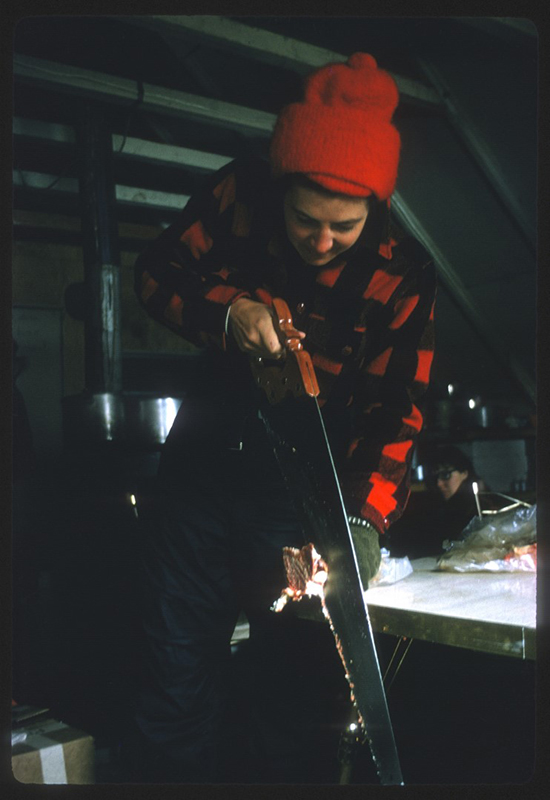
Inside the Lake Bonney hut, Lindsay saws a piece of frozen meat to prepare for dinner. Because of the broken furnace, keeping food frozen was not difficult.
Photo Credit: Image 601 Lois M. Jones Papers, SPEC.PA.56.0213, Byrd Polar and Climate Research Center Archival Program, Ohio State University
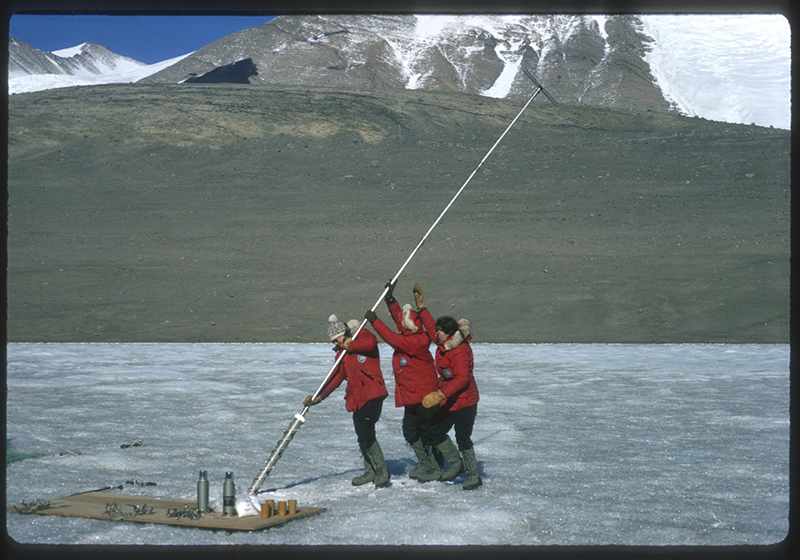
(Left to Right) Terry Tickhill, Kay Lindsay and Eileen McSaveney work together to hand auger through 14 feet of ice on Lake Bonney in the Taylor Valley.
Photo Credit: Image 567 Lois M. Jones Papers, SPEC.PA.56.0213, Byrd Polar and Climate Research Center Archival Program, Ohio State University

After drilling through 14 feet of ice by hand, Terry Tickhill (left) and Eileen McSaveney lowered a pump down the hole to sample the water underneath the Lake Bonney ice. They were examining chemical evidence of rock weathering in the lake.
Photo Credit: Image 605 Lois M. Jones Papers, SPEC.PA.56.0213, Byrd Polar and Climate Research Center Archival Program, Ohio State University

With Eileen McSaveney (right) assisting, Terry Tickhill digs through top soil in the Taylor Valley to uncover buried rock samples.
Photo Credit: Image 573 Lois M. Jones Papers, SPEC.PA.56.0213, Byrd Polar and Climate Research Center Archival Program, Ohio State University
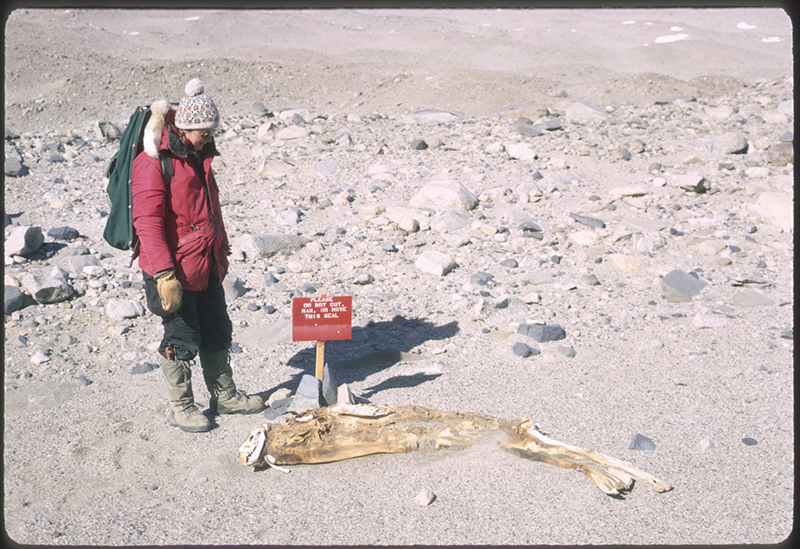
Terry Tickhill encounters a mummified seal in the Taylor Valley. Seals occasionally lose their way and migrate inland, away from the ocean. Their remains desiccate in the hyper arid-conditions and will remain for hundreds of years.
Photo Credit: Image 988 Lois M. Jones Papers, SPEC.PA.56.0213, Byrd Polar and Climate Research Center Archival Program, Ohio State University
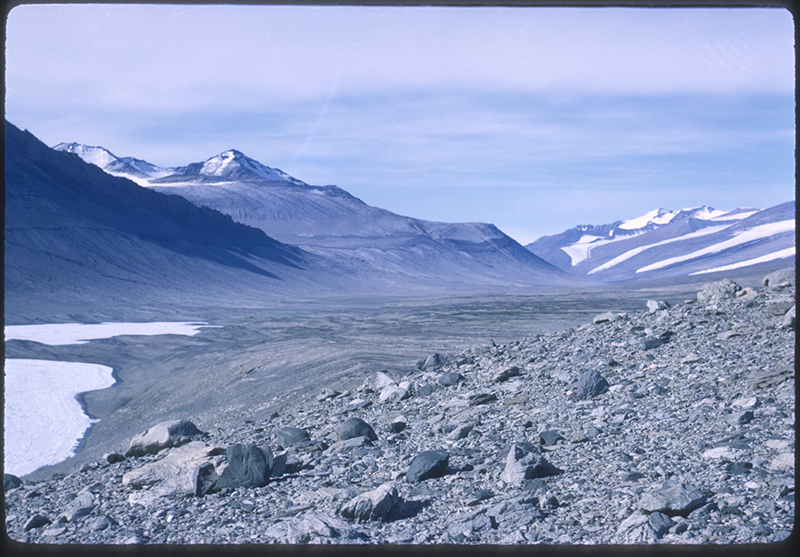
After about a month in the Taylor Valley, the team moved to the nearby Wright Valley, the focus of most of their work.
Photo Credit: Image 167 Lois M. Jones Papers, SPEC.PA.56.0213, Byrd Polar and Climate Research Center Archival Program, Ohio State University
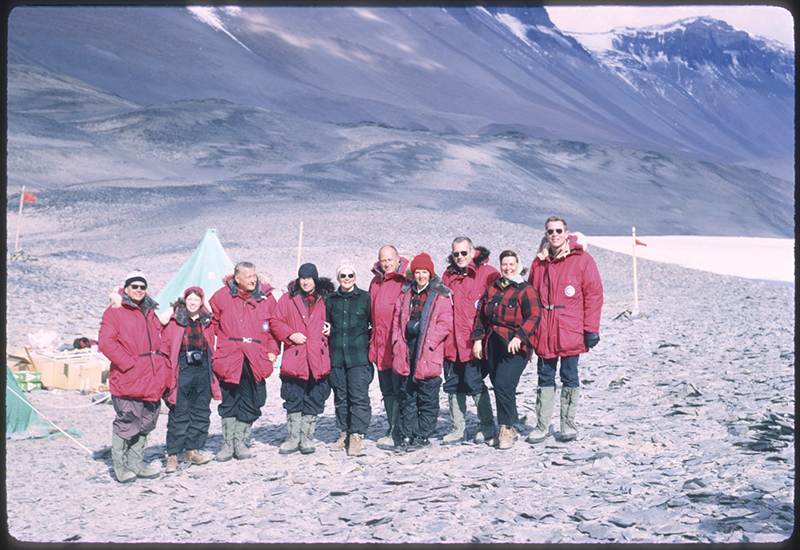
In January, not long after arriving in the Wright Valley, the research team encountered a tour of NASA distinguished guests. On the far right is Astronaut David Scott who would later walk on the moon during the Apollo 15 mission, and third from the right is Deke Slayton, then director of flight-crew operations, and who would later fly in space on board the joint U.S./Soviet Apollo-Soyuz Test Project.
Photo Credit: Image 1418 Lois M. Jones Papers, SPEC.PA.56.0213, Byrd Polar and Climate Research Center Archival Program, Ohio State University

Kay Lindsay, Terry Tickhill and Lois Jones collect a water sample from Don Juan Pond in the Wright Valley, the world's saltiest lake. They were looking to see if the lake brine showed evidence that they came from chemical weathering.
Photo Credit: Image 1367 Lois M. Jones Papers, SPEC.PA.56.0213, Byrd Polar and Climate Research Center Archival Program, Ohio State University

Like their work at Lake Bonney, the team drilled through feet of ice into Lake Vanda to sample the liquid water underneath.
Photo Credit: Image 1971 Lois M. Jones Papers, SPEC.PA.56.0213, Byrd Polar and Climate Research Center Archival Program, Ohio State University

(Left to right) Kay Lindsay, Eileen McSavney and Terry Tickhill pump water from Lake Vanda, looking for evidence of chemical weathering washing into the lake.
Photo Credit: Image 1119 Lois M. Jones Papers, SPEC.PA.56.0213, Byrd Polar and Climate Research Center Archival Program, Ohio State University
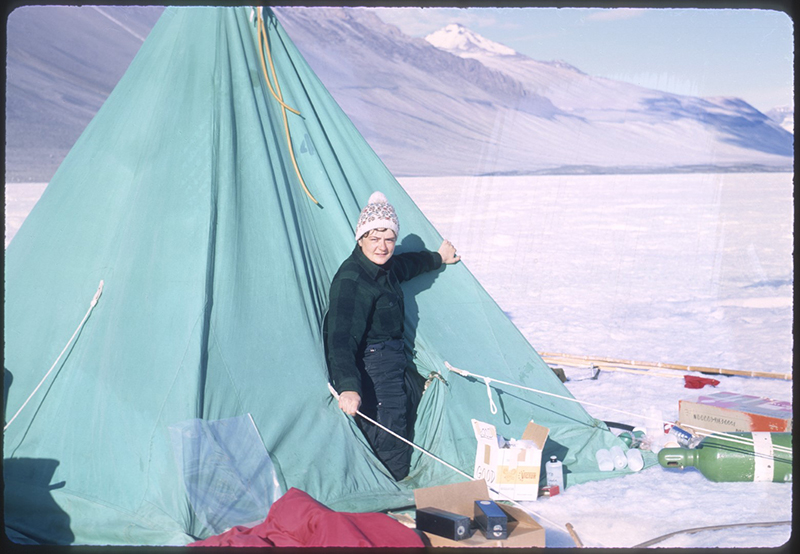
Terry Tickhill emerges from their Scott tent set up on top of the frozen Lake Vanda. They used the tent as a lab to conduct some preliminary tests of the water samples they collected from the lake.
Photo Credit: Image 892 Lois M. Jones Papers, SPEC.PA.56.0213, Byrd Polar and Climate Research Center Archival Program, Ohio State University
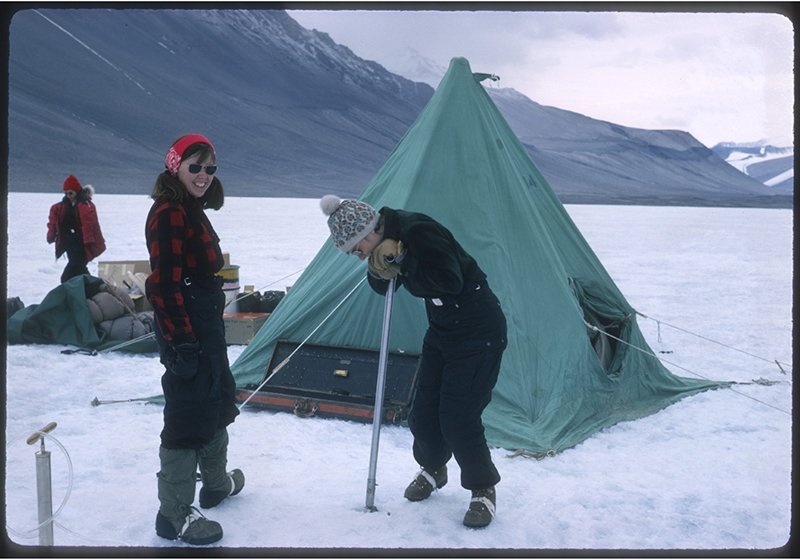
Eileen McSaveney and Terry Tickhill use a hand auger to drill into Lake Vanda. To the lower left is the hand pump that they used to collect water samples from the lake.
Photo Credit: Image 389 Lois M. Jones Papers, SPEC.PA.56.0213, Byrd Polar and Climate Research Center Archival Program, Ohio State University
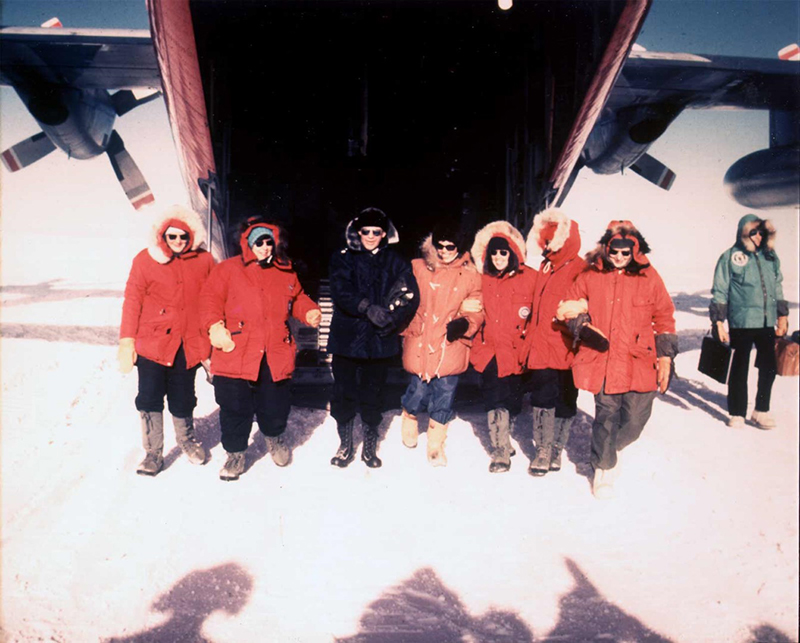
Before setting out for their fieldwork sites in the Dry Valleys, the research team made history as the first women to set foot at the South Pole on November 12, 1969. Though the trip was not required for their research, it showed to the world that women were as capable and proficient as men. The team was joined by Pam Young, a New Zealand biologist, and Jean Pearson, a reporter for the Detroit Free Press, as well as Rear Admiral Kelly Welch, commander of Naval Support Force Antarctica at the time. To make sure that no one of them were the "first" to walk off the plane, the team locked arms and stepped off the plane as one. (Left to right) Terry Tickhill, Lois Jones, Kelly Welch, Pam Young, Eileen McSaveney, Kay Lindsay, and Jean Pearson.
Photo Credit: U.S. Navy
|



For USAP Participants |
For The Public |
For Researchers and EducatorsContact UsU.S. National Science FoundationOffice of Polar Programs Geosciences Directorate 2415 Eisenhower Avenue, Suite W7100 Alexandria, VA 22314 Sign up for the NSF Office of Polar Programs newsletter and events. Feedback Form |

